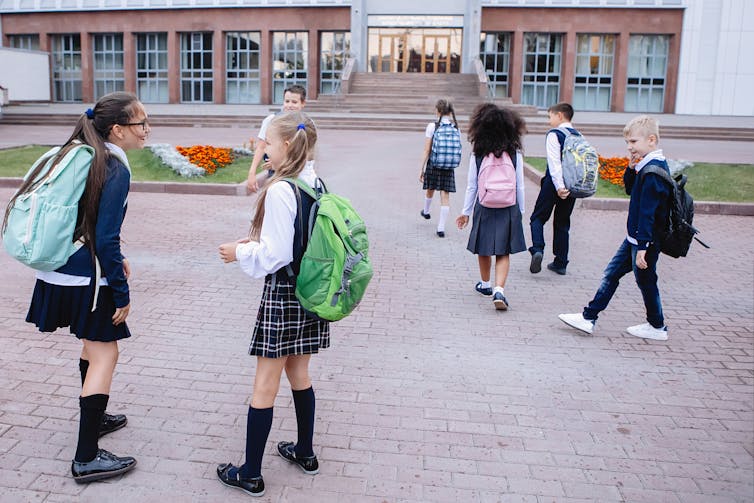
Bullying in schools is widespread, and it has consequences that can last through childhood and into adulthood. Research has found that children who are frequently bullied are more likely to self-harm, and being bullied in childhood has been linked with a higher risk of depression as an adult.
Bullying is preventable, but schools need more help in tackling it. While schools in England and Wales are required to have an anti-bullying policy, rates remain high. A 2023 report from charity the Anti-Bullying Alliance found that nearly a quarter of the over 65,000 children surveyed said they had been frequently bullied in the previous few weeks.
Generally, school policies seek to address the issue of how to tackle bullying when it occurs. However, there is evidence to suggest that an approach that encompasses the whole school to prevent bullying, as well as clear strategies to address confirmed bullying, are most effective.
Our research has tested the effectiveness of one of these whole-school approaches, the Kiva programme. This was a study with more than 11,000 children and found a 13% reduction in reported rates of bullying.
The Kiusaamisen Vastaan or “Kiva” programme was developed by researchers in Finland with government funding. Kiva is built on the social architecture model of bullying, which emphasises the significant roles played by bystanders in supporting or standing against bullying.
Bystander behaviour
This goes beyond seeing bullying as something that happens between a bully and their victim to also include those who help bullies, audiences that reinforce the bullying, silent observers who behave as if unaware of what is happening and those who help victims. The programme aims to change bystander behaviour towards helping victims, and stop bullying being a way for bullies to gain social status.
A large research study of more than 8,000 students in Finland showed significantly reduced bullying and victimisation among students aged seven to 11, including reduced cyberbullying. It also showed reduced rates of anxiety and depression. Since 2009, the programme has been rolled out nationally across Finland.
Our research has focused on exploring the effectiveness of the Kiva programme in the UK. Kiva was introduced to Wales in 2013; our study, carried out in 2021 and 2022 with 118 primary schools across Wales and England, is a rigorous evaluation of its effectiveness in the context of the UK school system.

We compared the Kiva approach with existing school practices to address bullying. Schools in Wales, Birmingham, Oxfordshire and Devon were randomly allocated to deliver Kiva or to continue with their usual practice.
The children at schools taking part in the Kiva trial had 20 45-minute lessons using this approach across the school year, which involved presentations, role play and group work. These class lessons cover how to make school a happy place, and to identify and stand against different forms of bullying. They also had access to educational online games to play at school and at home.
Staff members received training, including on scripted strategies to address incidents of bullying. These include information gathering from the victim, engagement with the bully or bullies to get them to commit to supporting the bullied child in some way (with or without requiring an admission of guilt) and work by the child’s class teacher to ask children who had not engaged in the bullying to support the victim. These strategies and decisions are reviewed after two weeks.
The Kiva programme was delivered to children aged between seven and 11, but involves elements that incorporate the whole school. These included posters on the walls, tabards worn by staff at break time to remind pupils that this is a Kiva school, and resources for parents.
We found a 13% reduction in reported victimisation after one year for those pupils on the Kiva trial as compared to those in schools with their usual policies. The trial also showed that children in the Kiva schools reported higher levels of empathy and reduced peer problems. The approach was equally effective across socio-economically diverse schools, and in schools ranging in size from small rural to large urban schools.
Our results show that the use of the Kiva programme can have the same positive effect in the UK as it has in Finland, and that the approach is a proven way for schools to reduce bullying and its harmful consequences.
![]()
Judith Mary Hutchings (known as Judy) is employed by Bangor University and her work on the KiVa Stand Together trial was grant funded by the National Institute for Health and Care Research -NIHR
This research was funded by the UK National Institute for Health and Care Research (NIHR) Public Health Research programme (17-92-11) for which I was a co-applicant. Intervention costs in Oxfordshire were funded by the Rayne Foundation (for which I was the PI of the grant). Other organisations also supported intervention costs, including GwE North Wales Regional School Improvement Service, Children’s Services, Devon County Council and HSBC Global Services (UK) Ltd.



